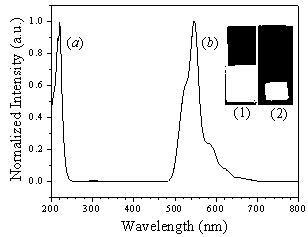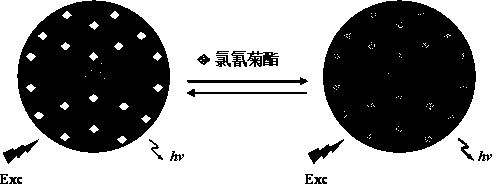A preparation method of y2o3:tb3+@sio2-nh2 fluorescent sensor array for detecting organochlorine pesticides
A fluorescent sensor and organochlorine technology, applied in the field of material science, can solve the problems of poor stability and low yield of organic green light-emitting materials
- Summary
- Abstract
- Description
- Claims
- Application Information
AI Technical Summary
Problems solved by technology
Method used
Image
Examples
preparation example Construction
[0053] 1. A Y for detecting organochlorine pesticides 2 o 3 :Tb 3+ @SiO 2 -NH 2 A method for preparing a fluorescent sensor array, characterized in that: the Y 2 o 3 :Tb 3+ @SiO 2 -NH 2 The imprinted recognition site inside the fluorescent sensor array can interact with the organochlorine pesticide molecule, so that the organochlorine pesticide molecule and the metal ion Tb on the recognition site 3+ Coordination to form organic ligands, using metal ions Tb 3+ The change of fluorescence intensity realizes the detection of organochlorine pesticide molecules, and its preparation process includes the following three steps:
[0054] 1.1 The first step is Y 2 o 3 :Tb 3+ Preparation of phosphor powder: First, weigh 1.8190 g ~ 1.8390 g Y with a ten-thousandth electronic balance 2 o 3 , 0.0729 g ~ 0.0749 g Tb 4 o 7 The solid was placed in a 50 mL single-neck ground-mouth flask, and then 10 mL of a mixed solution of concentrated nitric acid and water with a volume ratio...
Embodiment
[0057] Embodiment: utilize metal ion Tb 3+ Form an organic ligand with the organochlorine pesticide cypermethrin molecule and 3-aminopropyltriethoxysilane, and then use the sol-gel method-calcination to prepare the Y that selectively recognizes and sensitively detects cypermethrin 2 o 3 :Tb 3 + Phosphor, coated with SiO 2 And modified with APTS to get Y 2 o 3 :Tb 3+ @SiO 2 -NH 2 Fluorescent probe, prepared after plasma etching to obtain Y 2 o 3 :Tb 3+ @SiO 2 -NH 2 Fluorescence sensor array.
[0058] The first step is Y 2 o 3 :Tb 3+ Preparation of phosphor powder: First, weigh 1.8290 gY with a ten-thousandth electronic balance 2 o 3 , 0.0739 g Tb 4 o 7 The solid was placed in a 50 mL single-neck ground-mouth flask, and then 10 mL of a mixed solution of concentrated nitric acid and water with a volume ratio of 1:1 was added to the above flask, ultrasonically dispersed for 12 min, and then left to react for 20 min, then Add 15 mL of a mixed solution of tetrae...
PUM
| Property | Measurement | Unit |
|---|---|---|
| thickness | aaaaa | aaaaa |
Abstract
Description
Claims
Application Information
 Login to View More
Login to View More - R&D
- Intellectual Property
- Life Sciences
- Materials
- Tech Scout
- Unparalleled Data Quality
- Higher Quality Content
- 60% Fewer Hallucinations
Browse by: Latest US Patents, China's latest patents, Technical Efficacy Thesaurus, Application Domain, Technology Topic, Popular Technical Reports.
© 2025 PatSnap. All rights reserved.Legal|Privacy policy|Modern Slavery Act Transparency Statement|Sitemap|About US| Contact US: help@patsnap.com



